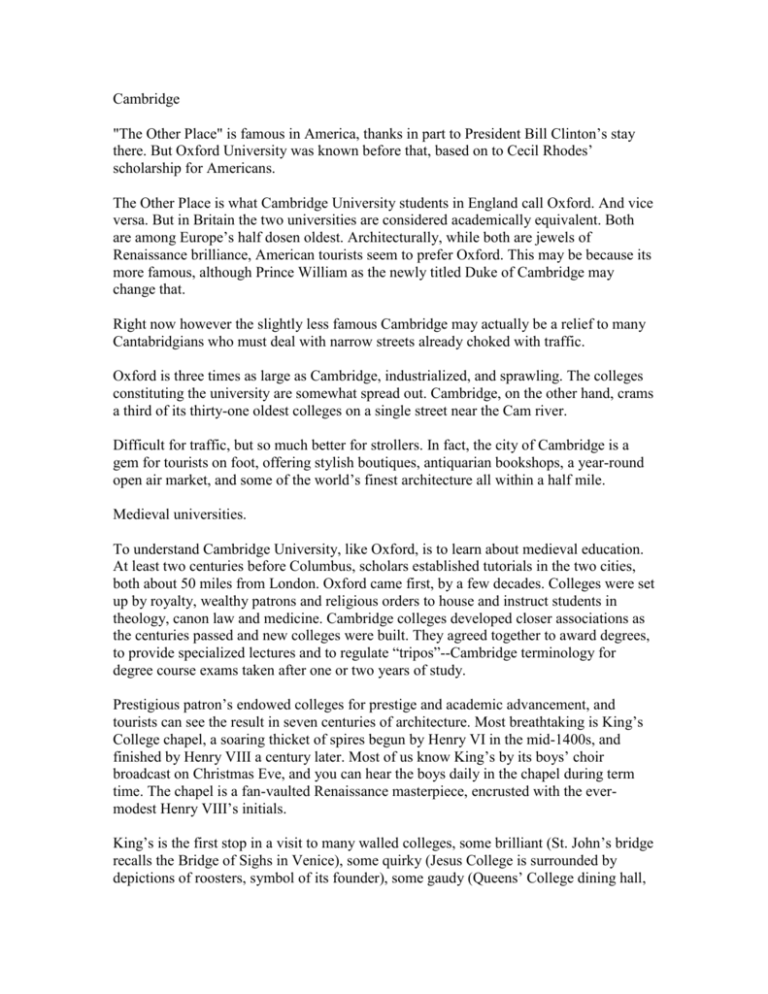Cambridge
advertisement

Cambridge "The Other Place" is famous in America, thanks in part to President Bill Clinton’s stay there. But Oxford University was known before that, based on to Cecil Rhodes’ scholarship for Americans. The Other Place is what Cambridge University students in England call Oxford. And vice versa. But in Britain the two universities are considered academically equivalent. Both are among Europe’s half dosen oldest. Architecturally, while both are jewels of Renaissance brilliance, American tourists seem to prefer Oxford. This may be because its more famous, although Prince William as the newly titled Duke of Cambridge may change that. Right now however the slightly less famous Cambridge may actually be a relief to many Cantabridgians who must deal with narrow streets already choked with traffic. Oxford is three times as large as Cambridge, industrialized, and sprawling. The colleges constituting the university are somewhat spread out. Cambridge, on the other hand, crams a third of its thirty-one oldest colleges on a single street near the Cam river. Difficult for traffic, but so much better for strollers. In fact, the city of Cambridge is a gem for tourists on foot, offering stylish boutiques, antiquarian bookshops, a year-round open air market, and some of the world’s finest architecture all within a half mile. Medieval universities. To understand Cambridge University, like Oxford, is to learn about medieval education. At least two centuries before Columbus, scholars established tutorials in the two cities, both about 50 miles from London. Oxford came first, by a few decades. Colleges were set up by royalty, wealthy patrons and religious orders to house and instruct students in theology, canon law and medicine. Cambridge colleges developed closer associations as the centuries passed and new colleges were built. They agreed together to award degrees, to provide specialized lectures and to regulate “tripos”--Cambridge terminology for degree course exams taken after one or two years of study. Prestigious patron’s endowed colleges for prestige and academic advancement, and tourists can see the result in seven centuries of architecture. Most breathtaking is King’s College chapel, a soaring thicket of spires begun by Henry VI in the mid-1400s, and finished by Henry VIII a century later. Most of us know King’s by its boys’ choir broadcast on Christmas Eve, and you can hear the boys daily in the chapel during term time. The chapel is a fan-vaulted Renaissance masterpiece, encrusted with the evermodest Henry VIII’s initials. King’s is the first stop in a visit to many walled colleges, some brilliant (St. John’s bridge recalls the Bridge of Sighs in Venice), some quirky (Jesus College is surrounded by depictions of roosters, symbol of its founder), some gaudy (Queens’ College dining hall, dated 1450, was painted wild red and green by Victorians who thought it matched medieval decorating schemes). You can also visit Trinity College (of "Chariots of Fire" movie fame) to see the bust of its illustrious fellows (faculty) and graduates, including Isaac Newton. Tour guides will point out the window to Prince Charles’ old room. You may walk the back streets on late afternoons and catch a glimpse of Stephen Hawking, discoverer of black holes, a man proclaimed to be the world’s greatest living physicist, and a fellow of Gonville and Caius College. Cambridge also has a well-labeled botanical garden, and the Fitzwilliam one of Europe’s most important museums. All of this is an easy walk, after an hour-long train trip from London. If your staying longer than a day, it’s worth renting a bicycle to get around like a local. More information: http://www.cam.ac.uk/.











